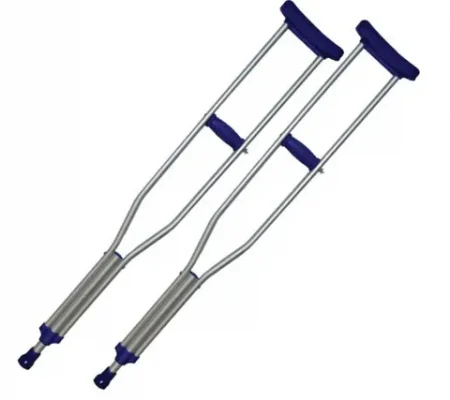Project Report For Crutches
Introduction
Project Report For Crutches is as follows.
Crutches, a type of walking aid, can be used to broaden a person’s base of support. Those who are unable to support their weight on their legs typically use them to shift weight from the lower to upper body (from minor injuries to lifelong impairments). Crutches are medical devices used to assist people who have difficulty walking due to an injury or disability.
Crutches are typically made of lightweight materials such as aluminum, which makes them easy to maneuver and carry. They come in different sizes to accommodate people of various heights and weights. Some crutches may also have adjustable features to provide a more comfortable fit.
Crutches are most commonly used to support people who have suffered an injury to their lower leg or foot, such as a fracture, sprain, or surgery. They can also be used to help people with chronic conditions that affect their ability to walk, such as cerebral palsy or multiple sclerosis.
Types Of Crutches
Underarm Crutches :- The most popular kind of crutches are axilla crutches, often known as underarm crutches. You may modify the height of these crutches, which are stored in your underarm when not in use. Although they are simple to use and balance, they may cause discomfort and exhaustion.
Forearm Crutches :- Lofstrand or elbow crutches are other names for forearm crutches. These crutches have grips that you may grab with your hands and a cuff that fits around your forearm. Those who require long-term crutches most frequently utilise forearm crutches.
Platform crutches :- Most of the patient’s weight is transferred to the user’s forearms. Although the platform crutch is less maneuverable than the axilla and forearm crutches, it offers the user additional stability. They are made to be used for an extended period of time. Platform crutches are an option for people who have severe neurological impairment of their lower extremities and poor stability over the long term.

Benefits Of Crutches
- Provides support: Crutches provide additional support to the body when walking, which can help to reduce the weight and pressure placed on the injured or weakened limb.
- Improves mobility: Crutches can help to improve mobility by allowing individuals to move around more easily, which can improve their overall quality of life and independence.
- Helps with balance: Crutches can help to improve balance by providing additional stability and support to the body, which can reduce the risk of falls and other accidents.
- Reduces pain: Crutches can help to reduce pain by taking pressure off the injured or weakened limb, which can help to alleviate discomfort and promote healing.
- Aids in recovery: Crutches can aid in the recovery process by allowing individuals to engage in physical therapy exercises and gradually increase their activity levels without putting too much strain on the injured or weakened limb.
Get Completely Custom Bankable Project Report
Market Potential of Crutches
The size of the worldwide market for medical crutches was projected at USD 727.4 million in 2022, and from 2023 to 2030, it is expected to grow at a CAGR of 6.5%.
Due to the huge number of procedures carried out each year across the world, There is a rising need for medical crutches. A contributing aspect to the growth in demand for medical crutches may be the enormous number of operations conducted globally.
In addition, osteoporosis and other ailments affecting the bones are highly prevalent around the world. Some of the factors driving the market’s growth include the rise in the number of accidents that leave people disabled throughout the world, the prevalence of lifelong illnesses, and technical advancements in the field of medical crutches. However, problems with crutch design limit the market’s growth.
In India, there are many older persons who have mobility issues brought on by age-related conditions including osteoporosis, arthritis, and other chronic illnesses. A surge in accidents, sports-related injuries, and other medical disorders that limit movement has also been seen. Crutches have become more popular recently, and this tendency is anticipated to continue in the future.

